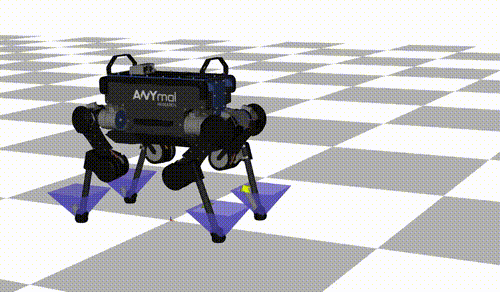This page explains the example code in examples/anymal/python/jump.py.

Required imports are as follows.
import numpy as np
import math
Definition: constraint_component_base.hpp:17
First, we define the robot model. We speficy the URDF path, base joint type, and contact frames (in this case, the contact frames are the frames of all feet).
model_info.
urdf_path =
'../anymal_b_simple_description/urdf/anymal.urdf'model_info.base_joint_type =
robotoc.BaseJointType.FloatingBase
baumgarte_time_step = 0.05
Dynamics and kinematics model of robots. Wraps pinocchio::Model and pinocchio::Data....
Definition: robot.hpp:32
Info of a robot model.
Definition: robot_model_info.hpp:24
std::string urdf_path
Path to the URDF file.
Definition: robot_model_info.hpp:73
- Note
baumgarte_time_step is the stabilization parameter for acceleration-level rigid contact constraints. The best choice of baumgarte_time_step may be the time step of the optimal control problem. However, it is often too small to make the optimization problem high nonlinear. A moderate value such as several times of the time step of optimal control problem may be sufficient
Then set the parameters for the optimal control problem of the jump motion such as the jump length
dt = 0.01
jump_length = np.array([0.5, 0, 0])
jump_height = 0.1
flying_up_time = 0.15
flying_down_time = flying_up_time
flying_time = flying_up_time + flying_down_time
ground_time = 0.30
t0 = 0
Next, we construct the cost function (TODO: write details about the cost function components).
q_standing = np.array([0, 0, 0.4792, 0, 0, 0, 1,
-0.1, 0.7, -1.0,
-0.1, -0.7, 1.0,
0.1, 0.7, -1.0,
0.1, -0.7, 1.0])
q_weight = np.array([0, 0, 0, 250000, 250000, 250000,
0.0001, 0.0001, 0.0001,
0.0001, 0.0001, 0.0001,
0.0001, 0.0001, 0.0001,
0.0001, 0.0001, 0.0001])
v_weight = np.array([100, 100, 100, 100, 100, 100,
1, 1, 1,
1, 1, 1,
1, 1, 1,
1, 1, 1])
u_weight = np.full(robot.dimu(), 1.0e-01)
q_weight_impact = np.array([1.0, 1.0, 1.0, 1.0, 1.0, 1.0,
100, 100, 100,
100, 100, 100,
100, 100, 100,
100, 100, 100])
v_weight_impact = np.full(robot.dimv(), 100)
config_cost.set_q_weight(q_weight)
config_cost.set_q_weight_terminal(q_weight)
config_cost.set_q_weight_impact(q_weight_impact)
config_cost.set_v_weight(v_weight)
config_cost.set_v_weight_terminal(v_weight)
config_cost.set_v_weight_impact(v_weight_impact)
config_cost.set_u_weight(u_weight)
cost.add("config_cost", config_cost)
robot.forward_kinematics(q_standing)
x3d0_LF = robot.frame_position('LF_FOOT')
x3d0_LH = robot.frame_position('LH_FOOT')
x3d0_RF = robot.frame_position('RF_FOOT')
x3d0_RH = robot.frame_position('RH_FOOT')
com_ref0_flying_up = robot.com()
vcom_ref_flying_up = 0.5*jump_length/flying_up_time + np.array([0, 0, (jump_height/flying_up_time)])
t0+ground_time, flying_up_time,
flying_down_time+2*ground_time, False)
cost.add("com_cost_flying_up", com_cost_flying_up)
com_ref0_landed = robot.com()
com_ref0_landed += jump_length
vcom_ref_landed = np.zeros(3)
t0+ground_time+flying_time, ground_time,
ground_time+flying_time, False)
cost.add("com_cost_landed", com_cost_landed)
Cost on the position of the center of mass.
Definition: com_cost.hpp:24
void set_weight(const Eigen::Vector3d &weight)
Sets the weight vector.
Configuration space cost.
Definition: configuration_space_cost.hpp:23
void set_q_ref(const Eigen::VectorXd &q_ref)
Sets the const reference configuration q.
Stack of the cost function. Composed by cost function components that inherits CostFunctionComponentB...
Definition: cost_function.hpp:30
Periodic reference of the center of mass.
Definition: periodic_com_ref.hpp:16
Next, we construct the constraints.
constraints.add("joint_position_lower", joint_position_lower)
constraints.add("joint_position_upper", joint_position_upper)
constraints.add("joint_velocity_lower", joint_velocity_lower)
constraints.add("joint_velocity_upper", joint_velocity_upper)
constraints.add("joint_torques_lower", joint_torques_lower)
constraints.add("joint_torques_upper", joint_torques_upper)
constraints.add("friction_cone", friction_cone)
Stack of the inequality constraints. Composed by constraint components that inherits ConstraintCompon...
Definition: constraints.hpp:30
Constraint on the inner-approximated firction cone.
Definition: friction_cone.hpp:22
Constraint on the lower limits of the joint position.
Definition: joint_position_lower_limit.hpp:22
Constraint on the upper limits of the joint position.
Definition: joint_position_upper_limit.hpp:22
Constraint on the lower limits of the joint torques.
Definition: joint_torques_lower_limit.hpp:22
Constraint on the upper limits of the joint torques.
Definition: joint_torques_upper_limit.hpp:22
Constraint on the lower limits of the joint velocity.
Definition: joint_velocity_lower_limit.hpp:22
Constraint on the upper limits of the joint velocity.
Definition: joint_velocity_upper_limit.hpp:22
Next, we construct the contact sequence robotoc::ContactSequence as
We set the contact positions and friction coefficients through the contact sequence. We then define the friction coefficients.
mu = 0.7
friction_coefficients = {'LF_FOOT': mu, 'LH_FOOT': mu, 'RF_FOOT': mu, 'RH_FOOT': mu}
We set the initial contact status of the robot. In the beginning, the robot is standing, so all the contacts are active.
contact_positions = {'LF_FOOT': x3d0_LF, 'LH_FOOT': x3d0_LH, 'RF_FOOT': x3d0_RF, 'RH_FOOT': x3d0_RH}
contact_status_standing = robot.create_contact_status()
contact_status_standing.activate_contacts(['LF_FOOT', 'LH_FOOT', 'RF_FOOT', 'RH_FOOT'])
contact_status_standing.set_contact_placements(contact_positions)
contact_status_standing.set_friction_coefficients(friction_coefficients)
contact_sequence.init(contact_status_standing)
Next, we set the contact status when the robot is flying. Then the all the contacts are inactive.
contact_status_flying = robot.create_contact_status()
contact_sequence.push_back(contact_status_flying, t0+ground_time)
Then a lift event is automatically appended into the contact sequence. Finally, we set the contact status after touch-down as
contact_positions['LF_FOOT'] += jump_length
contact_positions['LH_FOOT'] += jump_length
contact_positions['RF_FOOT'] += jump_length
contact_positions['RH_FOOT'] += jump_length
contact_status_standing.set_contact_placements(contact_positions)
contact_sequence.push_back(contact_status_standing, t0+ground_time+flying_time)
Then an impact event is automatically appended into the contact sequence.
- Note
- We can check the contact sequence via
Finally, we can construct the optimal control solver!
T = t0 + flying_time + 2*ground_time
N = math.floor(T/dt)
ocp =
robotoc.
OCP(robot=robot, cost=cost, constraints=constraints,
contact_sequence=contact_sequence, T=T, N=N)
Optimal control problem solver by Riccati recursion.
Definition: ocp_solver.hpp:41
The optimal control problem.
Definition: ocp.hpp:22
Options of optimal control solvers.
Definition: solver_options.hpp:17
int nthreads
Number of the threads of parallel computations. Must be positive. Default is 1.
Definition: solver_options.hpp:22
Let's run the solver!
t = 0.
q = q_standing # initial state.
v = np.zeros(robot.dimv()) # initial state.
ocp_solver.discretize(t) # discretizes the optimal control problem.
ocp_solver.set_solution("q", q) # set the initial guess of the solution.
ocp_solver.set_solution("v", v) # set the initial guess of the solution.
f_init = np.array([0.0, 0.0, 0.25*robot.total_weight()])
ocp_solver.set_solution("f", f_init) # set the initial guess of the solution.
ocp_solver.init_constraints() # initialize the slack and dual variables of the primal-dual interior point method.
print("Initial KKT error: ", ocp_solver.KKT_error(t, q, v))
ocp_solver.solve(t, q, v)
print("KKT error after convergence: ", ocp_solver.KKT_error(t, q, v))
print(ocp_solver.get_solver_statistics()) # print solver statistics
We can visualize the solution trajectory as
viewer =
robotoc.utils.TrajectoryViewer(model_info=model_info, viewer_type=
'gepetto')
viewer.set_contact_info(mu=mu)
viewer.display(ocp_solver.get_time_discretization(),
ocp_solver.get_solution('q'),
ocp_solver.get_solution('f', 'WORLD'))
- Note
- We can check the discretization of the optimal control problem sololy via
time_discretization.
discretize(contact_sequence, t)
print(time_discretization)
Time discretization of the optimal control problem.
Definition: time_discretization.hpp:20
void discretize(const std::shared_ptr< ContactSequence > &contact_sequence, const double t)
Discretizes the finite horizon taking into account the discrete events.
